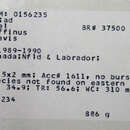en
names in breadcrumbs


Perception Channels: visual ; tactile ; acoustic ; chemical
Greater Shearwaters are not globally threatened. They are abundant with enormous total populations of a minimum 5 million breeding pairs on Tristan da Cunha, 600,000 to 3 million pairs on Gough Island, and small numbers on Falkland Islands. Their breeding range is restricted with only 4 sites known. Where the problem lies is with exploitation by Tristan islanders. Each year, a few thousand adults, and 50,000 chicks are taken. This could lead to a population collapse unless a quota system is established to allow for rational exploitation. More research is required in this area, as well as in the areas of the impact of harvesting on Greater Shearwaters, and the importance of other causes of mortality and population dynamics, in order to determine the maximum sustainable levels of exploitation. Another issue to be addressed is that of the occasional Greater Shearwater that is snared by fishermen's baited hooks.
Very little research has been done, but is required to ensure the maintenance of healthy populations of Puffinus gravis worldwide.
(del Hoyo, Elliot, and Sargatal 1992)
US Federal List: no special status
CITES: no special status
IUCN Red List of Threatened Species: least concern
In the past, Greater Shearwaters had been used to provide food and bait for seamen, but this practice has long since been discarded and aside from the occasional contact with fishermen, and Tristan islanders, P. gravis has mostly no contact with humans.
(del Hoyo, Elliot, and Sargatal 1992; Cassidy 1990)
Greater Shearwaters feed in groups where aggressive intraspecific feeding competition is evident through lashing with bills and wings. They eat mostly fish and squid, with occasional feeding on crustaceans, fish entrails, and other refuse discarded by fishing vessels. They hunt by plunge-diving from heights of 6-10m or taking prey from surface seizing or pursuit diving.
Surface-seizing consists of the 'walking on water' that is usually associated with Storm Petrels. Without entirely folding its wings, a Greater Shearwater lands on the water surface with its feet, balances with its wings, and "walks" forward over the water as it picks up food from near the surface.
Plunge-diving involves striking the water surface from heights of 6-10 m with belly and feet and then instantly lowering the head under the water surface to lead into a smooth submersion. Occasionally, a Greater Shearwater might briefly halt 0.5 m above the water surface, spread its feet, then plunge headfirst underneath the water. After the dive, the bird bursts out of the water and almost directly into flight.
(Brown, Bourne, and Wahle 1978; del Hoyo, Elliot, and Sargatal 1992; Gooders 1978)
Greater shearwaters are a marine species distributed throughout the region of the Atlantic ocean. Puffinus gravis breed in the far south Atlantic, mainly on the islands of the Tristan da Cunha group, the Falkland Islands, and Gough Island. P. gravis then migrates to the North Atlantic during the winter, reaching noth-east Canada and sometimes reaching as far north as Greenland. Migration to the breeding grounds involves a flight east, past Britain and Iberia, than turning south to reach their Southern Hemisphere breeding grounds.
(del Hoyo, Elliot, and Sargatal 1992; Farrand 1985; Gooders 1978)
Biogeographic Regions: oceanic islands (Native ); atlantic ocean (Native )
P. gravis is a marine, pelagic bird species, frequenting cool offshore and pelagic waters, and breeding on sloping ground, mainly in grassland or woodland areas (del Hoyo, Elliot, and Sargatal 1992; Gooders 1978)
Average lifespan
Status: wild: 85 months.
Puffinus gravis is a large shearwater species, 43-51cm in length, with a wingspan of 100-118cm. Colouring is unique with a combination of pale underparts with a poorly defined dark patch on the belly. White bands of plumage occur across the uppertail-coverts and also across the hindneck, emphasizing the Greater Shearwaters strongly capped appearance. Upperparts are dark gray-brown to black with light feather edgings to give a scaled appearance. Flight feathers have black upper- and undersurfaces. The tubenosed bill is long, thin, and black. The legs are pink to grey with webbed feet, and eyes are brown. Chicks have bluish-grey down and juveniles are similar to adults but greyer with paler fringes to feathers to give less scaled appearance. There is no sexual dimorphism in terms of size or colour between males and females.
(Campbell 1974; del Hoyo, Elliot, and Sargatal 1992; Farrand 1985; Gooders 1978)
Range mass: 715 to 950 g.
Other Physical Features: endothermic ; bilateral symmetry
The breeding season commences in October and often lasts until December. Breeding takes place in the Southern Hemisphere and is restricted to the far south oceanic islands: Tristan da Cunha group, Falkland Island, and Gough Island. Puffinus gravis is a colonial nester, nesting in burrows or crevices among boulders along hilly island shores. The female produces a single, white, oval, and slightly pointed egg. The egg is incubated for 53-57 days, and an altricial offspring is then hatched. Both male and female care for young. Offspring become independent of their parents at about 105 days. (del Hoyo, Elliot, and Sargatal 1992; Gooders 1978)
Key Reproductive Features: iteroparous ; gonochoric/gonochoristic/dioecious (sexes separate); sexual ; oviparous